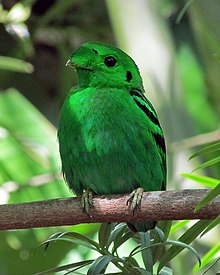| Calyptomenidae | |
|---|---|

| |
| Green broadbill (Calyptomena viridis) | |
| Scientific classification | |
| Domain: | Eukaryota |
| Kingdom: | Animalia |
| Phylum: | Chordata |
| Class: | Aves |
| Order: | Passeriformes |
| Suborder: | Tyranni |
| Infraorder: | Eurylaimides |
| Superfamily: | Eurylaimoidea |
| Family: | Calyptomenidae Bonaparte, 1850 |
Calyptomenidae is a family of passerine birds found in Africa, the Malay Peninsula and Borneo. There are six species in two genera.
The species in this family were formerly included in the broadbill family Eurylaimidae. A molecular phylogenetic study published in 2006 found that the species in these two genera were not closely related to the other broadbills.[1] These two genera are now placed in a separate family.[2]
Genera
[edit]The family contains six species in two genera:[2]
| Image | Genus | Living species |
|---|---|---|
 |
Smithornis Bonaparte, 1850 |
|
 |
Calyptomena Horsfield, 1822 |
|
References
[edit]- ^ Moyle, R.G.; Chesser, R.T.; Prum, R.O.; Schikler, P.; Cracraft, J. (2006). Phylogeny and evolutionary history of Old World suboscine birds (Aves: Eurylaimides). American Museum Novitates, Number 3544. New York: American Museum of Natural History. hdl:2246/5822.
- ^ a b Gill, Frank; Donsker, David, eds. (2019). "NZ wrens, Sapayoa, broadbills, asities, pittas". World Bird List Version 9.2. International Ornithologists' Union. Retrieved 26 June 2019.
Well, that’s interesting to know that Psilotum nudum are known as whisk ferns. Psilotum nudum is the commoner species of the two. While the P. flaccidum is a rare species and is found in the tropical islands. Both the species are usually epiphytic in habit and grow upon tree ferns. These species may also be terrestrial and grow in humus or in the crevices of the rocks.
View the detailed Guide of Psilotum nudum: Detailed Study Of Psilotum Nudum (Whisk Fern), Classification, Anatomy, Reproduction